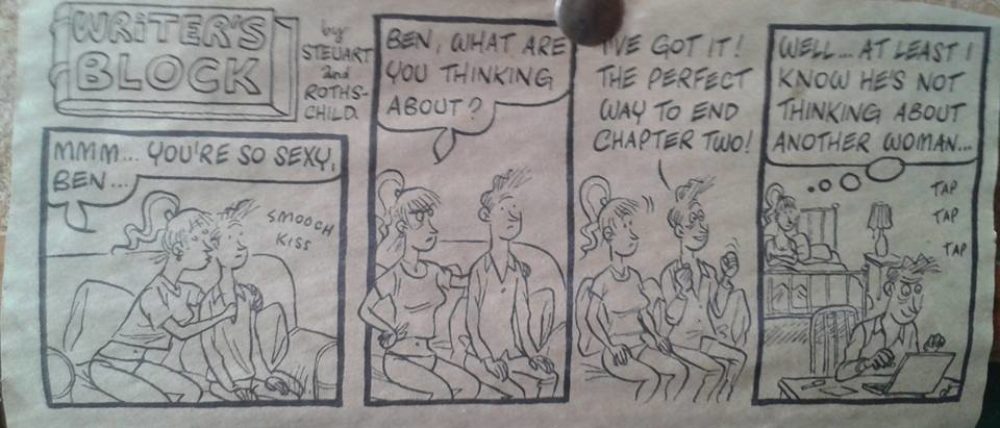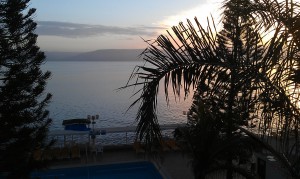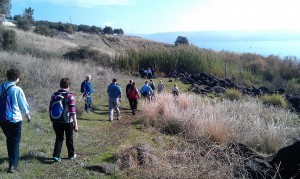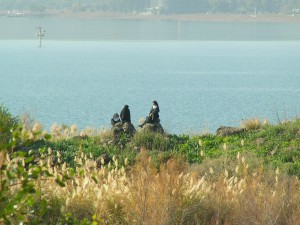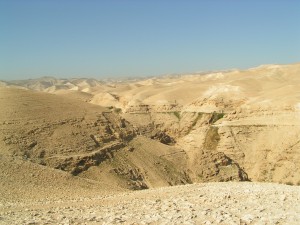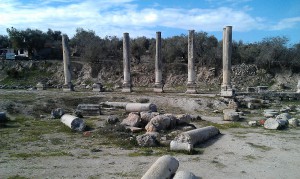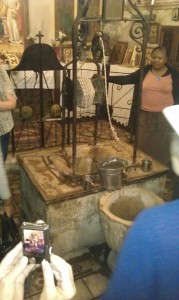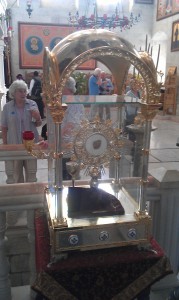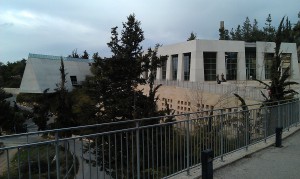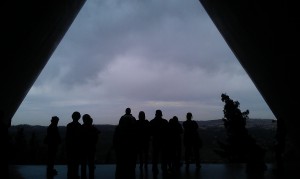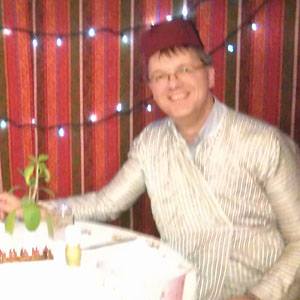I had never seen myself as a pilgrim. I’m too low church to do saints and martyrs: for me it’s the boss man or nothing, which really limits the range of pilgrimage activity to Israel. (Or the Americas if you’re Mormon, but alas, what can I say?) But even if I went to Israel, I thought, what wouId do when I got there? I understood (correctly) that very little survives of anything Jesus might have seen or touched. Even if it’s a confirmed Jesus location – and I have severe doubts about the Church of the Holy Sepulchre – it’s all either about 30 feet below present day street level, or buried beneath a church (or in extreme cases an entire religious community). So it came as quite a surprise to find myself not only going to Israel on a pilgrimage, but going for a good cause as well.
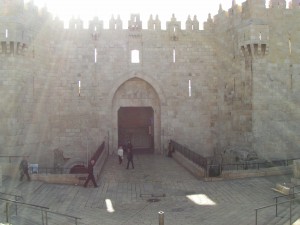
A case in point about Jerusalem street levels: the Damascus Gate. At bottom left you can just see the top of the NT era gateway.
What changed? One was reading about the Western Wall Tunnel, a tour you can take of the very foundations of the Temple Mount, including the blocked-up Warren’s Gate. Jesus may or may not have been born on the site of the Church of the Nativity; the church suspended over the ruins of Capernaum may or may not be bang over the home of Peter’s mother in law. These things are unknowable. But, unless he levitated into the Temple (and the gospels are pretty silent on the subject if he did), Jesus walked through that gate. I wanted to see it.
Another was learning about McCabe Pilgrimages, who do an all-in trip at a very reasonable rate. And we were making holiday plans for 2014. And … Anyway, a pilgrimage to Israel it was.
There was another reason too, which I’ll come to in a later post.
Stepson asked if every day would include readings from The Pilgrim’s Progress. I said no, and asked why he thought it might. He replied that it was the only book he could think of about pilgrims.
“What about The Canterbury Tales?”
“Is that about pilgrims? But it’s got rude bits …”
Anyway. And so it came to pass that we spent two nights in Tiberias, at the wonderful 4-star Ron Beach Hotel, and five in Jerusalem, travelling with a group to explore Biblical sites, which is the best way to do pilgrimage. Unless you’re inclined to solitary meditation, you need the fellowship. Sharing communion and singing hymns on top of the (possible) Mount of the Beatitudes is a powerful experience. Our time in Galilee incorporated the Mount, Capernaum, Magdala (where we were pleased to see a church is under construction dedicated to Mary Magdalene and all the women of the Bible) and the Church of Multiplication, the (possible) location of the miracle of loaves and fishes.
(Typing “possible”, “alleged” or “traditional” will become wearisome after a while. From here on, I’ll take a page from our guide’s book and mostly present everything as fact, leaving it to you to work out what I actually believe, what is commonly held by many to be true though I disagree, and what I dismiss as utter nonsense.)
But it also included a walk of a couple of miles along the lake shore, through the kind of scrubby, sun-dried landscape that the original crowds would have known, and that was when the pilgrimage really began to sink in. I should have said that very little manmade survives of Jesus’s times. Well, what does survive very definitely is the geography. The gospel writers never mention – possibly because they knew it so well that it was hardly worth mentioning – that the Sea of Galilee is surrounded by high ground which plunges down into the water. Every lakeside scene would have had the land rising sharply behind it, and the rising land lends itself wonderfully to acoustics. In places you can clearly hear a normal speaking voice some 50 metres away; you can understand how Jesus preached to multitudes there.
And I felt I could understand why Jesus spent so much of his ministry in this place. Even for a hard working fisherman, Galilee on a quiet day is marvellously serene and quiet. Jesus needed somewhere to start introducing his life- and world-changing ministry where he wouldn’t immediately be drowned out by the next loud voice. He chose an environment where fresh ideas can quietly settle into people’s heads, soaking in and refreshing like the morning dew.
Geography also cut in later on in the trip, when we ventured east past Jerusalem into the Judean wilderness. Beyond the watershed of the Judean mountains, where moisture from the Mediterranean no longer blows, the land turns suddenly harsh and dry, arid and sunbaked, pure geology in front of your eyes. It’s land that would burn away the irrelevancies from the life of anyone who spent time there.
It’s the geography of the Holy Land that will stay with me for a long time, and that alone is worth a pilgrimage for.
After Tiberias we travelled south over the fertile plains and hills of the West Bank to Jerusalem, stopping at Sebaste (capital of Samaria, where Herod Antipas enjoyed the dancing) and Shechem (location of Jacob’s Well and Jesus’s encounter with the Samaritan woman).
I drank from Jacob’s Well and, in accordance with scriptural prophecy, felt thirsty again. In the church there is a relic of St Photini, the woman Jesus spoke to at the well. Opinion is divided on whether it’s a bit of skull or kneecap but, hey, relic.
In Jerusalem we stayed at the Palestinian-owned Golden Walls Hotel, just outside the north wall close to the Damascus Gate. This has its own pilgrimage significance as it is where General Charles Gordon was sitting one day when he noticed that a nearby rock face – now at the back of a bus station – looked roughly skull-like, and of course Golgotha was the Place of the Skull. Being a decisive man of action (and as Generals will do, once they get an idea into their heads) he decided that QED this must be the place where Christ was crucified, not the seething, Crusader-blingtastic tastefail of the Church of the Holy Sepulchre. More on that later.
As well as all the expected religious sites I particularly wanted to see the Yad Vashem Holocaust memorial and museum. Oh my. You know the saying that before you criticise someone, walk a mile in their shoes? (That way, when you criticise them they’re a mile away and you’ve got their shoes …) Yad Vashem lets you walk 2000 years in the shoes of the Israelis. And yes, you can still criticise them, because they should be criticised – but you can start to see where they’re coming from too.
It doesn’t just throw you into the Holocaust – oh no. You would walk straight into that with all your defences on full and miss half the impact. You need to be softened up first. And so our guide, a sweet Jewish lady from the ancient tribe of Mancunian, started centuries ago with church-sponsored anti-semitism, then a whistlestop tour up to the 1930s, and then it hits you, from the first anti-Jew laws and the gradual erosion of rights up to the mass deportations and industrial-scale exterminations. And of course, nothing was magically cured just because the war ended, so we get the unhappy experiences of the British Mandate before finally, we reach 1948 and the foundation of the state.
The penultimate stop is the hall of records. Yad Vashem is mandated by law to give a name and identity to every Jewish victim of the Holocaust. They are pretty sure they won’t make it; too many have died, taking their memories with them. But they’ve got to >4m out of 6m, which ain’t bad, and they intend to keep going.
All this, I should have said, involves working your way along a not overly bright subterranean tunnel. Finally you emerge into the light and onto a balcony overlooking Jerusalem. Symbolism? What symbolism?
I wasn’t expecting sweetness and light, but I also wasn’t expecting to be moved to tears. Two items came damn close. The first was the story of a talented teenage artist called Petr Ginz, born 1928. One of his paintings was a moonscape and you can see it by following the link: this boy dreamed of going into space. He died in Auschwitz aged 16, but his painting did make it into space, taken there by an Israeli astronaut. And that was the point where I nearly lost it, because I know my space shuttle history, and I knew the only mission to take an Israeli astronaut was Columbia’s last. Sure enough, our guide said, both picture and astronaut were lost when Columbia disintegrated on re-entry.
The second item was the Children’s Memorial. A circular passageway takes you around a handful of lit candles, only 3 or 4, but the passageway is lined with mirrors in near pitch dark. The reflections of the flames above and below and all around you make it like you’re walking through the firmament. Meanwhile a disembodied voice reads the name, age and place of dying of every known child victim of the Holocaust.
This is turning into a long post so I’ll deal with what actually brought us to Jerusalem in another one. But Yad Vashem is a bum note to end on, so: that evening at the hotel we were treated to a “traditional” Arab feast, Leilat Sultan. Everyone got given a cardboard crown to wear and one of them had SULTAN written inside the rim. The lucky man was Sultan for the evening, and guess who that turned out to be?
Perks of being Sultan were to be first in line for the food and leading off the dancing, and choosing my Queen for the evening. Of course there could be only one contender for that vacancy and she looked beautiful in her Queenly robes and jewels. As for me. I wore a fez, and fezzes are, as everyone knows, cool.
Watch this space for part 2 …
